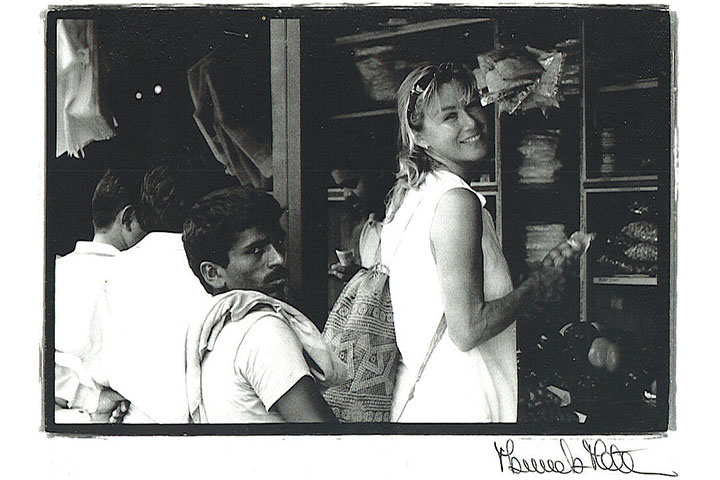
21 Jul Alumni Spotlight – Davina Stephens ’87
Davina Stephens, a New Zealand born artist, discovered her love for art right here in Woodstock. Having lived in some of the world’s most culturally diverse places like Indonesia, India, and Italy, Davina commenced her career early on as just a student in high school. After graduating, she attended the Fashion Institute of Technology in New York which served as an important part of her journey to become the artist she is today. After settling in Indonesia many years later, her art quickly gained traction for its bold colors and intriguing stories. In recent years, she has explored more contemporary realms of art which have been challenging and thought-provoking. Much of her art relates to modern issues like global warming and inequality. Her latest exhibition explored more minimalistic features while simultaneously expressing a strong connection to the culture of Bali.
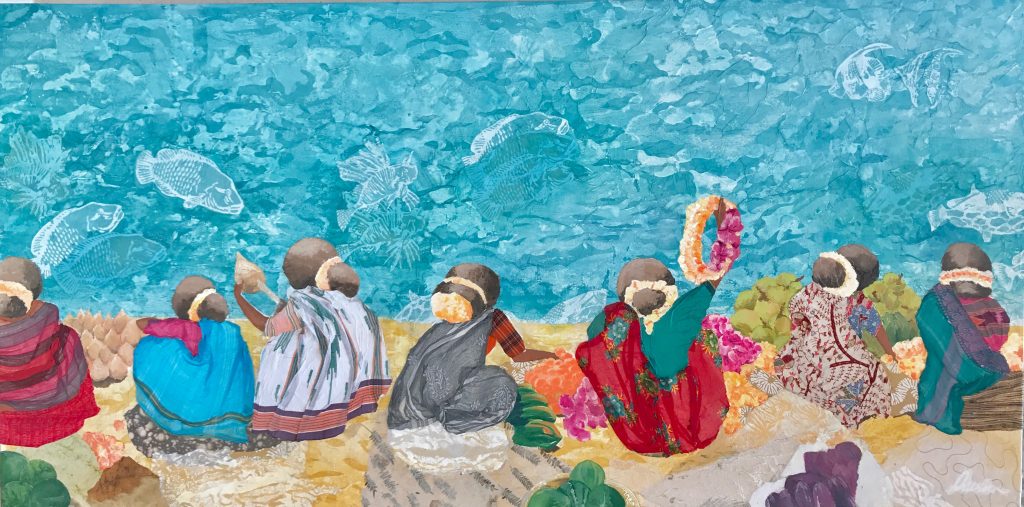
Goan Women 2 – 200x100cm woodblock print acrylic collage on canvas – By Davina Stephens
I can only imagine the culture shock for anyone to move from Bali to Mussoorie. What was the best and worst thing about living in Mussoorie?
The best thing was meeting and interacting with other kids from all around the world. Next, of course, was the location and the sense of total isolation in the foothills of the Himalayas. The teachers themselves were quite interesting because they were maybe not as traveled, but they did well in how they taught and what they did. Overall, it was really interesting for everybody that was attending and teaching at the school. Quite an incredible community! I would have to say the worst thing was probably that I was only there for a short time of two and a half years. So, when I first got there the weather was cold and I was more used to tropical weather because I had been living in Australia. I was basically taken unmoved to go to school there, in a place where we were kind of kids ruling. But the fact that we were kids living under one roof together who had to create our own independence, made the experience very profound.
You describe your Woodstock experience as very profound. What role did Woodstock play in your search for success on a personal level and as an artist?
Since we didn’t have a big art department, most of the students were doing their SATs and could also opt to do A or O levels. Since I knew I liked art, I had to do something with art, but I knew I had to make money with it. Since there were only two of us pursuing art at Woodstock, I wanted to try to achieve my schooling in A and O levels, because I felt it was much more recognized internationally. SATs were kind of just American, whereas I was focusing more on Europe, as I felt that Europe was the capital of where I was aiming to be, go to an art school or do something like that. I also learned French and German in school, I never stopped at one language. I never learned Hindi and I kid myself for that because in the end that would have been the most useful for me, since I spent a lot of time in India continuously after that. So, I learned French and German and there were only two of us in the A levels O levels, plus I did English literature so that kind of went hand in hand.
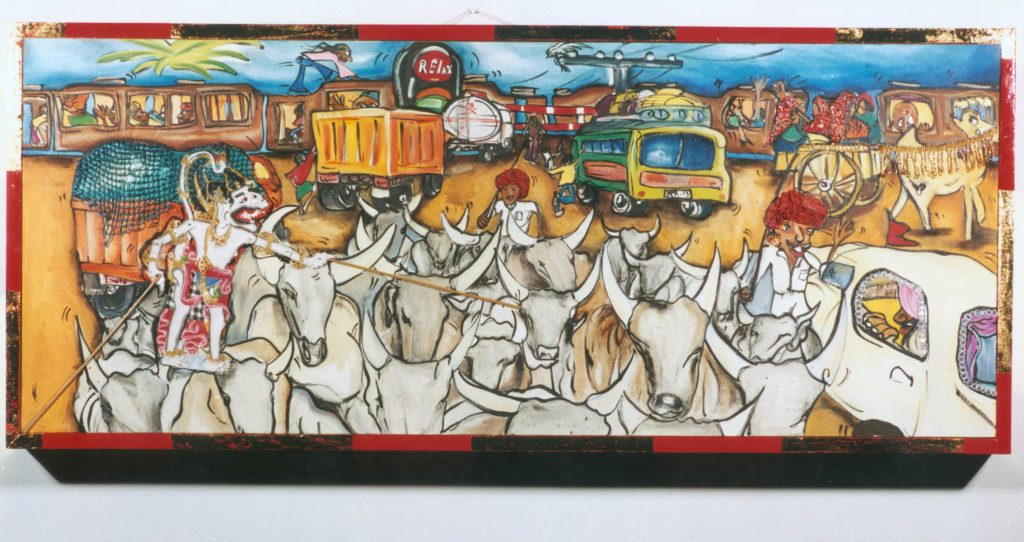
9.mad cows 130 x 55 cm collage and oil on canvas – By Davina Stephens
Growing up in Indonesia and spending time in remote places like Mussoorie and Sardinia must have played an important role in your approach towards art. What are some of your most valuable inspirations from living in these cultural hotspots?
I think it’s more like this, I remember I did this exhibition called “tribes on a moon,” why did I do an exhibition called tribes on the moon? Because it’s kind of similar to the way I was seeing things and looking at things. I traveled a lot and met people from different countries, different locations, I lived in different diverse places. I felt that my role was to educate through pictures, paintings and art by having stories behind the artworks, to educate people who may not have had those opportunities that I had or it could also be for people who would like to have the same opportunities to see other places. It’s that desire to erase ignorance somehow of multiculturalism and diversity for people to understand that there are so many rich cultures other than their own. So, I felt like I had a reason, a purpose behind the art. I’m not an installation artist, I’m not awakening in contemporary art but at least I can somehow share the experience of my practice and of my travels with people who have an interest in it.
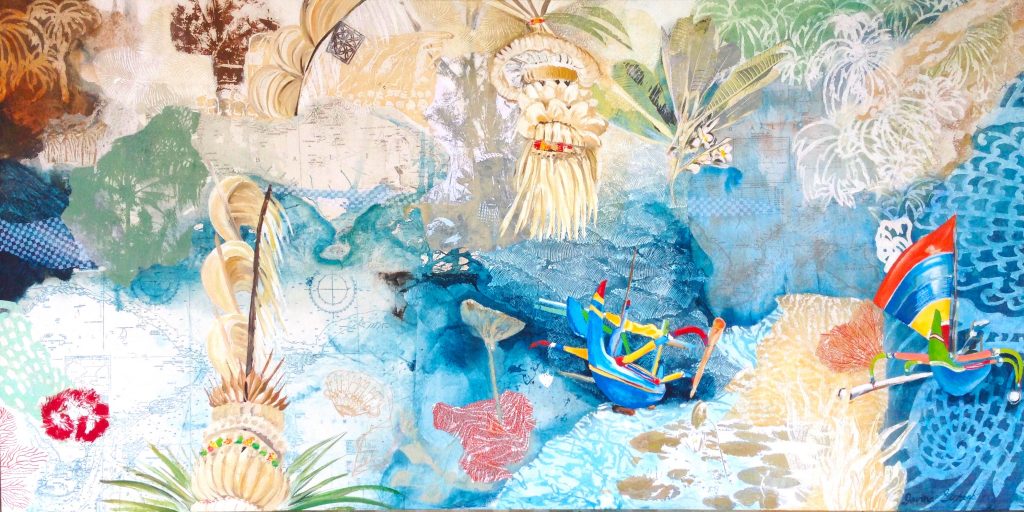
Wendys Bali: Davina high res 72dpi – By Davina Stephens
How do you define success and what are some of the most distinctive moments that have defined your career as an artist?
Success depends on every individual and their character. There are some people who have this urge to achieve or prove something and they set a goal, or an aim that they want to become that or be that. And so, everybody does, pretty much kind of envisions a situation, position, direction or set goals depending on which curriculum they’re in. I would say of course as an artist you go, yes! The whole world can see my art, it would be fantastic! And being an international artist would be a wonderful proclamation to achieve! Well, asking at this age, success is when you are content in your day to day or rather happy in your day to day life. But you have to have some feeling of you’ve done something to improve or change the way the world is going.
I’ve had many exhibitions and these exhibitions happened because I made them happen. I didn’t rely on curators or galleries; I was an independent pretty much a self-taught artist. I think the energy and certainty I had in myself and my work, created those exhibitions. I had one or two every year. It was something I needed to do and had to do to gain satisfaction to give myself reassurance that I’m doing the right thing. I didn’t want to fail at being an artist and I think I believed in myself enough for me to have to not rely on a gallery.
I feel satisfied and I look at my artwork as a learning, as a practice. I set challenges and I’m still constantly learning about my art. I have got to remember this is what my career is, so it’s what also earns me my money. You can’t just be relaxed, be yourself, you’ve got to push boundaries. Somehow create your own platform and I have had to create my own platform. I have worked with galleries, but I’m not set with any gallery. I have maintained my freedom to move and work hard, not work hard, time to play, or time to work, that’s the balance of life because we could die tomorrow.
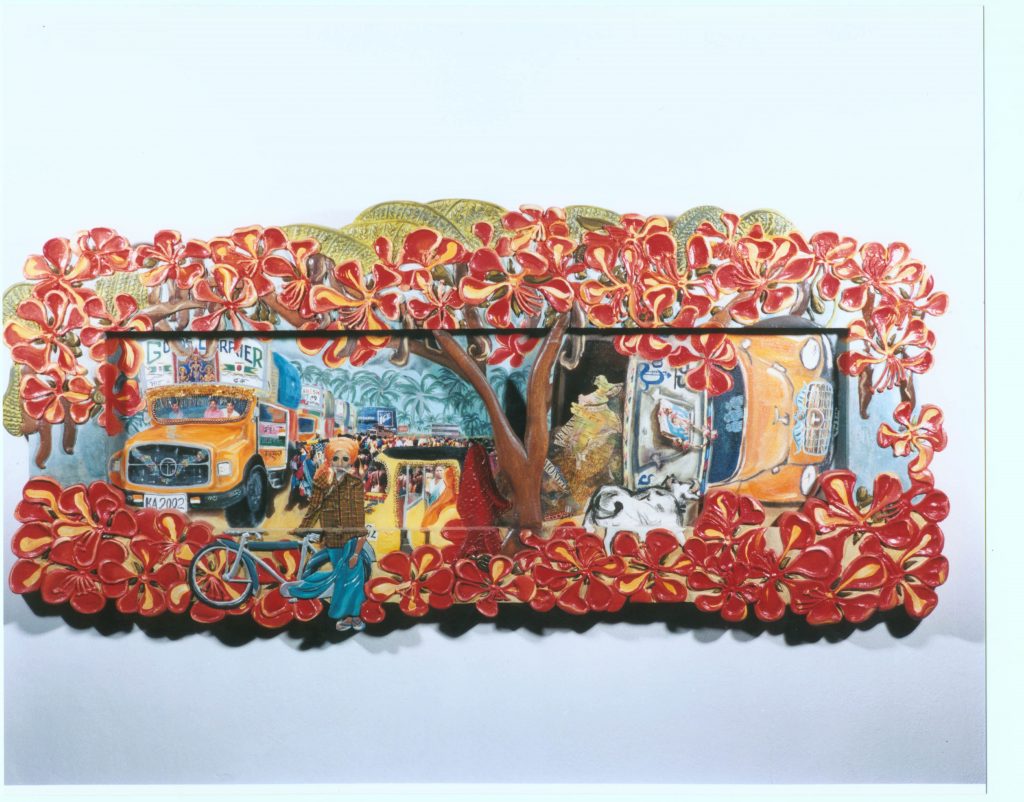
ca. Flamboyant 200 x 80 x 4cm oils collage and wood 2005 – By Davina Stephens
Organizing an exhibition is often very complex. What goes on behind the scenes and what words of wisdom would you give to an up-and-coming artist in the early stages of their career?
Firstly, it’s important to establish a relationship with a gallery that you respect. You have to do research and go around. Let’s say you land in a city like Auckland for example, first thing you would do is go around and look at all the different galleries, introduce yourself and try to engage in conversation with the gallery owners. Then you have to understand what the market is like. Also, you have to understand first that there are many different types of artists. Some artists are part of groups and they collaborate to produce work together. Then you’ve got the independent artists who work alone and as being a lone working artist, I would see which galleries appeal to me, what kind of reputation they have, and then I would aim for those. Open discussion creates relationships and if you live in the city you have to work on it. You have got to research and create a relationship with the galleries and keep checking in. Don’t just limit yourself to one gallery, it’s like applying for a job, you put down 50 applications, but you make sure all of them are places you would want to work in. You really have to envision your art being there.
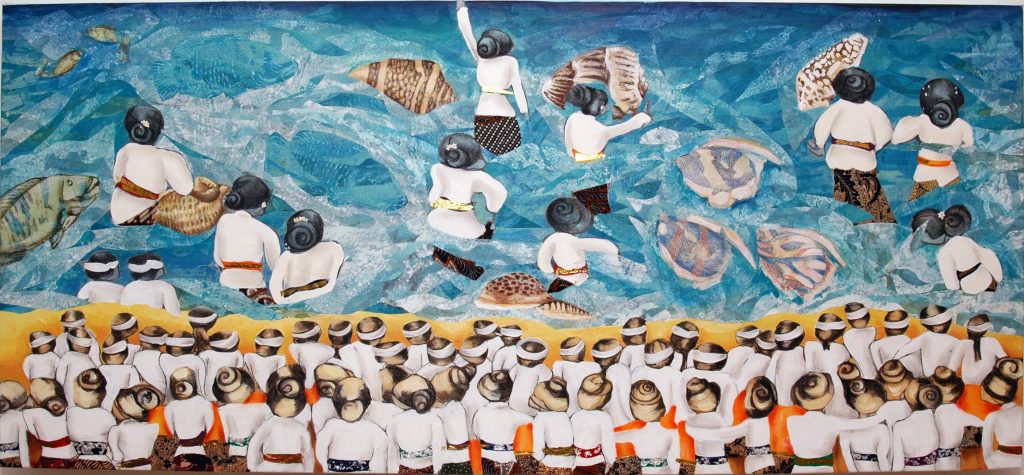
Upacara Pekelem High res dpi 300
Are you currently working on any projects?
I did have a project before COVID-19 and had just come out of an exhibition which I was really proud to be in. It was called Art Bali. They have Art Jogja and Art Jakarta, and for me that was a time of recognition. I got recognized in the contemporary art world in Indonesia and that was a proud time for me. That was in October last year and I had come out with something completely different to what I do. It wasn’t paintings, it wasn’t installations, it was wood and based on memory. It was really appropriate as it was the material that I usually worked with and because I do a lot of block printing, I basically just went from being a painter to, “let’s start looking at the other materials and not be just a painter.” I mean I had done some installations before, but this stood out. It was so simple but so beautiful, but so loud and even though it was just white on white, you couldn’t really see it, you had to feel it! What’s interesting is in Indonesia everything’s so elaborate and the history of art in Indonesia is so baroque, like over decorated and so it was good. Normally my paintings are filled up with things and this was so minimal it was exciting.
I was going to do a small exhibition in Bandung in Java that has now been postponed to October. I talked with the curators and they have a subject interest with me because I am always interested in the roots of culture, people, and places. I have travelled in India, Indonesia, been to Madagascar, have also now been to Polynesia and the islands, and I’m from New Zealand born in New Zealand. What do all these regions have in common? It’s the Austronesian peoples. They arrived from Taiwan and the highland cultures of Taiwan and then they migrated down through the Philippines all the way through Malaysia, Indonesia, Micronesia Melanesia and into the Pacific. So, what links all that up quite nicely is the language. Even though a painter can still write words on painting, I never liked words in paintings. But it’s become a way to start a discussion or find stories among them. Like migration lines that are interesting, that can be revealed to people that have never heard of it before. So, it’s this tapping into cultures and histories and stories.
– Araan Neil Suares, Class of 2021, Head Alumni Intern
Visit Davina’s website to see more of her work – www.davinastephens.com

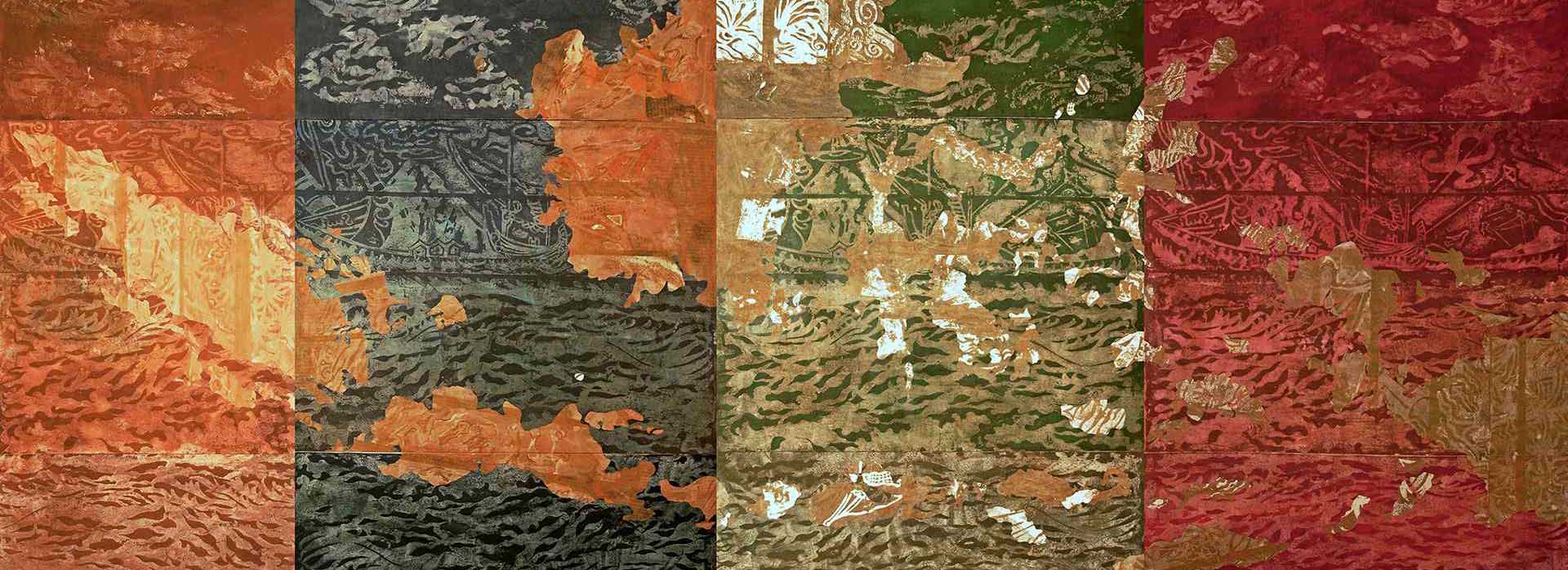




Wilhelmina E Barton
Posted at 01:26h, 09 OctoberWhy can I not access the article on Ruchi Narain?
Will Ferguson
Posted at 09:03h, 22 OctoberDear Wilhelmina, I’m not sure why, as it should be accessible to everyone. Please could you try again? https://www.woodstockschool.in/alumni-spotlight-ruchi-narain-91/